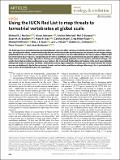Files in this item
Using the IUCN Red List to map threats to terrestrial vertebrates at global scale
Item metadata
| dc.contributor.author | Harfoot, Michael B. J. | |
| dc.contributor.author | Johnston, Alison | |
| dc.contributor.author | Balmford, Andrew | |
| dc.contributor.author | Burgess, Neil D. | |
| dc.contributor.author | Butchart, Stuart H. M. | |
| dc.contributor.author | Dias, Maria P. | |
| dc.contributor.author | Hazin, Carolina | |
| dc.contributor.author | Hilton-Taylor, Craig | |
| dc.contributor.author | Hoffmann, Michael | |
| dc.contributor.author | Isaac, Nick J. B. | |
| dc.contributor.author | Iversen, Lars L. | |
| dc.contributor.author | Outhwaite, Charlotte L. | |
| dc.contributor.author | Visconti, Piero | |
| dc.contributor.author | Geldmann, Jonas | |
| dc.date.accessioned | 2021-11-24T12:30:03Z | |
| dc.date.available | 2021-11-24T12:30:03Z | |
| dc.date.issued | 2021-11 | |
| dc.identifier | 276803719 | |
| dc.identifier | 9e1994ef-f980-4c71-9405-0018289f4706 | |
| dc.identifier | 000691203100001 | |
| dc.identifier | 85113919416 | |
| dc.identifier.citation | Harfoot , M B J , Johnston , A , Balmford , A , Burgess , N D , Butchart , S H M , Dias , M P , Hazin , C , Hilton-Taylor , C , Hoffmann , M , Isaac , N J B , Iversen , L L , Outhwaite , C L , Visconti , P & Geldmann , J 2021 , ' Using the IUCN Red List to map threats to terrestrial vertebrates at global scale ' , Nature Ecology and Evolution , vol. 5 , no. 11 , pp. 1510-1519 . https://doi.org/10.1038/s41559-021-01542-9 | en |
| dc.identifier.issn | 2397-334X | |
| dc.identifier.other | ORCID: /0000-0001-8221-013X/work/103866027 | |
| dc.identifier.uri | https://hdl.handle.net/10023/24389 | |
| dc.description | Funding: This work is supported by the Cambridge Conservation Initiative collaborative grants programme (all), the EU’s Horizon 2020 Marie Skłodowska-Curie action (grant no. 706784, J.G.), VILLUM FONDEN (grant no. VKR023371, J.G.), Independent Research Fund Denmark’s Sapere Aude (grant no. 0165-00018B, J.G.), UK Research and Innovation’s Global Challenges Research Fund: Trade, Development and the Environment Hub project (grant no. ES/S008160/1, N.D.B and M.B.J.H) and the KR Foundation and Hempel Foundation (‘Designing a brighter future for biodiversity’, N.D.B. and M.B.J.H.) | en |
| dc.description.abstract | The Anthropocene is characterized by unparalleled human impact on other species, potentially ushering in the sixth mass extinction. Yet mitigation efforts remain hampered by limited information on the spatial patterns and intensity of the threats driving global biodiversity loss. Here we use expert-derived information from the International Union for Conservation of Nature Red List on threats to 23,271 species, representing all terrestrial amphibians, birds and mammals, to generate global maps of the six major threats to these groups: agriculture, hunting and trapping, logging, pollution, invasive species, and climate change. Our results show that agriculture and logging are pervasive in the tropics and that hunting and trapping is the most geographically widespread threat to mammals and birds. Additionally, current representations of human pressure underestimate the overall pressure on biodiversity, due to the exclusion of threats such as hunting and climate change. Alarmingly, this is particularly the case in areas of the highest biodiversity importance. | |
| dc.format.extent | 23 | |
| dc.format.extent | 6082272 | |
| dc.language.iso | eng | |
| dc.relation.ispartof | Nature Ecology and Evolution | en |
| dc.subject | Biodiversity | en |
| dc.subject | Conservation | en |
| dc.subject | Invasion | en |
| dc.subject | Worlds | en |
| dc.subject | Land | en |
| dc.subject | Diversity | en |
| dc.subject | Progress | en |
| dc.subject | Impact | en |
| dc.subject | Last | en |
| dc.subject | GE Environmental Sciences | en |
| dc.subject | QA Mathematics | en |
| dc.subject | QH301 Biology | en |
| dc.subject | DAS | en |
| dc.subject | SDG 13 - Climate Action | en |
| dc.subject | SDG 15 - Life on Land | en |
| dc.subject.lcc | GE | en |
| dc.subject.lcc | QA | en |
| dc.subject.lcc | QH301 | en |
| dc.title | Using the IUCN Red List to map threats to terrestrial vertebrates at global scale | en |
| dc.type | Journal article | en |
| dc.contributor.institution | University of St Andrews. Statistics | en |
| dc.contributor.institution | University of St Andrews. Centre for Research into Ecological & Environmental Modelling | en |
| dc.identifier.doi | https://doi.org/10.1038/s41559-021-01542-9 | |
| dc.description.status | Peer reviewed | en |
This item appears in the following Collection(s)
Items in the St Andrews Research Repository are protected by copyright, with all rights reserved, unless otherwise indicated.

